
The site provides reference information for informational purposes only. Diagnosis and treatment of diseases must be carried out under the supervision of a specialist. All drugs have contraindications. Consultation with a specialist is required!
Prevalence of rosacea
Causes of rosacea
The causes of this disease are not fully understood, but there are a number of theories according to which diseases of the stomach and endocrine system, disorders in the immune system, hereditary factors, etc. play a certain role in the occurrence of rosacea.
I. External factors in the development of rosacea. It is assumed that the consumption of spices, as well as coffee and alcoholic beverages, leads to an effect on the gastric mucosa, which causes the dilation of blood vessels on the face as a reflex.
The assumption that rosacea develops due to excessive consumption of meat turned out to be incorrect, because... The disease also occurs among vegetarians.
A number of scientists have put forward theories about the occurrence of rosacea when drinking coffee and drinks containing caffeine (Coca-Cola), but experiments have proven that redness on the face appears not so much due to the consumption of these drinks, but due to hot liquid entering the stomach (above 60°C). And, nevertheless, patients with rosacea are recommended to exclude spicy foods, coffee, alcoholic drinks and citrus fruits from their diet.
II. Infectious theory. Since pustules appear on the face with rosacea, it is assumed that an infectious factor – bacteria – plays a certain role in the development of the disease. This theory is confirmed by the fact that when antibiotics are prescribed, the manifestations of rosacea are significantly reduced. But in the contents of the pustules it was never possible to detect a virus or bacteria that could be the cause of this disease.
III. The role of mites. The appearance of rosacea is associated with exposure to Demodex mites. This theory is supported by the detection of mites when taking material from some areas of the skin, and a partial effect when prescribing treatment aimed at destroying the mites. But, due to the fact that mite larvae are not found in all patients, this theory has not received final confirmation. When mites are found in rosacea, a diagnosis is made rosacea-like demodicosis .
IV. Hereditary factor. A genetic predisposition to the development of rosacea is denied by most scientists. However, studies conducted in the United States have shown that in 40% of patients with rosacea, this disease also occurs in close relatives. Family cases of the disease are also described in the literature.
V. The role of diseases of the digestive system. Opponents of this theory deny the possible connection of stomach and intestinal diseases with the development of rosacea. But studies have shown that 50-90% of patients with rosacea have signs of gastritis, and 35% have symptoms of small intestinal diseases.
VI. Theory of mental disorders. For a long time, mental disorders were considered one of the main causes of rosacea, but numerous studies have not confirmed this fact. The connection between mental illness and rosacea is that in severe forms of rosacea, patients may develop mental conditions in the form of depression, depressed mood and emotional instability.
Clinical picture of the disease
1. Initial stage of rosacea (otherwise known as rosacea diathesis, or episodic erythema). This period is characterized by the periodic appearance of redness in the cheeks, nose and middle part of the forehead. In addition to the face, rosacea can also appear on the chest (in the décolleté area).
The following factors can trigger the first attack of redness:
- hot drinks (tea, coffee);
- hot spicy food;
- exposure to strong winds;
- overheating or hypothermia of the body;
- alcohol consumption;
- stressful situation;
- taking medications;
- cosmetics applied to the face;
- the onset of menopause;
- physical stress.
Patients with the erythematous form of rosacea give the impression of modest, nervous, and shy people. Attacks of facial redness gradually occur more often, and then persistent patches of bright red color appear on the forehead, cheeks and nose, which eventually become bluish. This is due to damage to the superficial veins, which begin to appear through the skin in the form of spider veins. In addition to the listed symptoms, facial swelling, burning sensation and peeling of the skin also appear.
2. Stage of papulopustular manifestations. With the papulopustular form of rosacea, pimples and pustules begin to appear against the background of facial redness. Rosacea acne lasts for several weeks and occurs in clusters. After they disappear, scars, as a rule, do not remain, or they are barely noticeable. Swelling of the facial skin is located mainly in the forehead and in the area between the eyebrows. At this stage, the skin's sensitivity to sunlight increases. After prolonged exposure to the sun, bumps appear on the skin (solar comedones). The burning and tingling sensation of the skin subsides at this stage. Gradually, pustular rashes affect the entire skin of the face, scalp, chest area and, in rare cases, the back. The rash on the head is accompanied by severe itching.
3. Phymatoid stage. As the disease progresses, at this stage some patients' skin begins to thicken, causing it to appear bumpy, resembling an orange peel. Thickening of certain parts of the face often occurs - the ears, nose, forehead. The most common complication, which occurs mainly in men, is thickening of the nose. This thickening in Greek is called рhyma , which means a bump - accordingly, the nose is called pineal. The pineal nose (or rhinophyma) is enlarged in size, has a bluish coloration with many blood vessels. Gradually, deep grooves appear that divide the nose into separate tuberous lobules. Less commonly, similar changes appear on other areas of the skin: thickening of the eyelids, skin of the chin, pillow-shaped thickening of the skin of the forehead, cauliflower-like growth of the earlobe. These symptoms of rosacea practically do not occur in women, which is due to the possible influence of female sex hormones.
Eye damage due to rosacea
Special forms of rosacea
- Conglobate rosacea. This form is characterized by the appearance of huge spherical growths on the reddened skin - conglobates . This situation often occurs when taking medications that contain iodine or bromine.
- Steroid rosacea. It develops in people who use local hormonal ointments (especially with fluoride) for a long time for a particular skin disease. The steroid form of rosacea is very difficult to treat.
- Lightning form. Develops mainly in young women. Among the factors that can cause this form of rosacea are neuropsychiatric disorders, pregnancy, and hormonal changes in the body during menopause. The fulminant form is the most complex variant of conglobate rosacea. The disease develops suddenly and progresses rapidly, leading to facial disfigurement. Against the background of such an appearance, young women often develop depressive states and neuroses. Treatment of rosacea on the face in this form has a very low effect.
- Rosacea-lymphoedema (edematous form). A rather rare variant of the skin disease rosacea, manifested by severe swelling of the face, which is located on the cheeks, chin, forehead, nose and eyes. The swelling has a purplish color, and when pressed, there is no hole left on it, because the face swells not due to fluid, but due to the proliferation of the subcutaneous layer. The general condition of this form suffers little, but facial disfigurement is severe.
Diagnosis of rosacea
Concomitant diseases of the digestive system and the detection of Demodex mites will also speak in favor of the disease.
Rosacea treatment
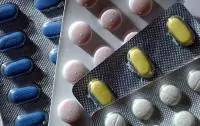
Since there are many factors that provoke and aggravate the course of rosacea, treatment methods are also varied. The use of some drugs is aimed more at reducing rosacea on the face, while other drugs and methods are used to treat concomitant diseases of the nervous system and digestive organs.
1. Use of antibiotics. The most effective in treating rosacea are antibiotics from the tetracycline group (oxytetracycline, tetracycline hydrochloride, doxycycline, minocycline). Also, one of the most effective remedies for rosacea has long been a drug such as metronidazole (or trichopolum). There is no consensus on the mechanism of its action. It has been reliably established that metronidazole for rosacea has an anti-edematous effect and enhances the restorative abilities of the intestinal and gastric mucosa. Metronidazole is also effective against a large number of bacteria and Demodex mites.
2. Local treatment. Creams, gels and ointments are used, sold in ready-made form, as well as complex mash, made in pharmacies according to a doctor's prescription. 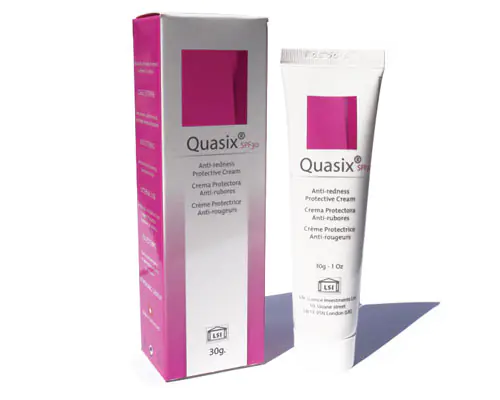
Rosacea is treated with the following topical remedies:
- Creams and gels of the Quasix group with quassia extract. When treating rosacea, this group of drugs relieves inflammation, itching, eases the course of the disease and, with regular use, transfers the disease to a stage of long-term remission.
- Skinoren gel is one of the most effective treatments for rosacea. The main component of the gel is azelaic acid, which provides anti-inflammatory, decongestant and drying effects. Apply Skinoren gel in a thin layer after first washing and drying the facial skin. Since the drug is a medicinal product and not a cosmetic one, the effect of its use is noticeable only with regular use. Skinoren for rosacea can be used by people of any gender and age; it is not contraindicated for use even during pregnancy and breastfeeding.
- Creams and gels containing metronidazole (Rosex, Rozamet, Metrogyl). For rosacea, such gels relieve inflammation, reduce the number of pustular rashes and partially even out the surface of the skin.
- Hormonal ointments and creams for rosacea. Recently, the use of ointments containing hormones is not recommended. Such products give a quick effect, which is especially noticeable if you take photos before and after treatment. Therefore, in most cases, the use of hormonal cream leads to good results. But discontinuation of these drugs leads to a rapid return of symptoms, and even to the development of a severe steroid form of rosacea. Creams containing fluorine, bromine or iodine are also not recommended.
- Ovante cream (contains microencapsulated crystalline sulfur and a large number of plant ingredients). Gives a good cosmetic effect, is safe and can be used for a long time.
3. If there are a large number of spider veins, it is prescribed vitamin preparation ascorutin, strengthening the walls of blood vessels.
4. Antiallergic drugs in case of severe inflammation and itching (suprastin, fenkarol, tavegil).
5. Soothing agents on the nervous system (valerian, motherwort, sage).
6. Physiotherapy methods of treatment. For rosacea, phototherapy will help to cope with small spider veins, and the use of laser can help get rid of larger vascular formations. Laser treatment for rosacea helps remove visible blood vessels and helps smooth the skin surface. A course of treatments with dry ice or liquid nitrogen is also effective.
Since some physiotherapeutic methods (in particular, laser treatment for rosacea) are quite expensive, many patients wondering “how to cure rosacea” resort to traditional medicine and homeopathy.
Treatment of rosacea with folk remedies
Traditional methods of treating rosacea very often give a good cosmetic effect. It is better to start treatment and skin care for rosacea with lotions. For this, decoctions, juices and plant extracts can be used. One of the most important conditions for effective treatment is that all solutions must be cooled!
The following herbs and plants are used to treat rosacea:
- Calendula. You can use ready-made calendula tincture purchased at the pharmacy. 50 ml of tincture is diluted in a glass of cold water. Soak a towel or gauze folded in several layers with the resulting solution. After squeezing a little, the gauze is applied to the face for 3 hours. The procedure is carried out once a day.
- Chamomile. For rosacea rosea, use an infusion of flowers (prepared in a ratio of 1:15). After preparing the solution, the same procedure is performed as with calendula.
- A series. To prepare the infusion, use 1 part herb to 30 parts water. A napkin moistened with the solution is applied to the face for 30 minutes.
- Cranberry. At home, you can treat rosacea with cranberry juice. Wet-dry dressings are most effective. To do this, gauze folded in 10 layers is soaked in cranberry juice, then applied to the face, covered with a layer of cotton wool on top. Secure this bandage with a bandage and leave it for 30-60 minutes. If you are using cranberries for the first time, the juice should be diluted with water in a ratio of 1:3. If the skin reacts well, you can gradually increase the concentration and switch to undiluted cranberry juice.
For rosacea and rosacea (spider veins), oatmeal and kefir masks have a good effect.
Oatmeal mask. Grind two tablespoons of oatmeal into powder, pour in 100 ml of hot water and let it brew. After cooling the flakes to room temperature, apply a thin layer of the paste to your face for 40 minutes. Have a wet wipe with you. It is necessary to wet the dried areas of the mask.
Kefir mask. After soaking a gauze napkin with fresh kefir, apply it to your face for 10 minutes. It is recommended to perform the procedure daily.
Diet for rosacea

It is extremely important for patients with rosacea to maintain a healthy diet. It is better to eat little by little and regularly. It is necessary to limit as much as possible the consumption of any canned foods, salt, sausages, vinegar, pepper and other spices, any fried foods, animal fats, and sweets. It is not recommended to eat fruits such as oranges, grapes, tangerines and pears. You should forget about alcoholic drinks, strong hot coffee and tea.
What is possible? Your diet should include lean meats - boiled, stewed or steamed. You can eat fish, boiled eggs, butter and vegetable oil, potatoes. Cabbage, carrots, beets and fresh cucumbers, berries, apples and plums, dill and parsley, rhubarb, beans, any fermented milk products, cereals (buckwheat, rice, oatmeal), and unleavened bread are also allowed.
In severe forms of the disease, a doctor may prescribe therapeutic fasting for 5 days:
1st day: in the morning the patient drinks a 10% solution of magnesium sulfate for 30 minutes, and then during the day drinks only mineral water (Borjomi, Narzan, etc.) with a total volume of 1000-1500 ml.
Day 2: drink up to 2 liters of mineral water.
3rd day: kefir, fermented baked milk, vegetable oil, 200 g of boiled potatoes, 20-25 g of butter, stale white bread or crackers (200 g), unsweetened tea, cottage cheese, vegetable soup, apples, fresh cucumbers are consumed.
4th day: in addition to the products of the previous day, you can eat fish or boiled meat (100 g), as well as cereal products.
Day 5: You can include any vegetables and berries allowed for rosacea in your diet.
Using cosmetics for rosacea
How to treat rosacea has already been discussed. But proper hygiene and cosmetic care is no less important. In winter and autumn, you need to protect your facial skin from strong wind, cold, snow and rain. In summer and spring, it is recommended to protect your skin from direct sunlight: wear a wide-brimmed hat, dark glasses, or use a sun umbrella. It is also necessary to apply sunscreen with SPF 15 or higher to your face before going outside. Visiting the sauna and solarium is prohibited.
Rosacea disease requires the use of only mild cosmetics. It’s good if they contain extracts of grapefruit, blueberries, chamomile, and cucumber. All cosmetics for rosacea (lotions, tonics, creams) should not contain alcohol, and it is better to choose from those products that are marked “hypoallergenic” or “anti-rosacea”. In order for cosmetics to have healing properties, and not just mask the manifestations of the disease, you can add a solution of dimexide to them.
It is always necessary to apply a protective cream under decorative cosmetics.
For rosacea in men, it is recommended to use an electric razor. Blades can only be used if they are very sharp.
The application and removal of cosmetics must be extremely gentle: do not rub creams too hard or rub your face with a towel after washing.
Prevention of rosacea
Author: Pashkov M.K. Content Project Coordinator.
Rosacea is a chronic and poorly understood dermatological condition that characteristically affects people with pale skin, blue eyes, and typically begins in middle age. People with darker skin tones may also suffer from rosacea, but the signs of the disease will not be as noticeable. The disorder is always accompanied by redness, often with small papules (or bumps) that can turn into pimples. It is often confused with acne.
However, acne has nothing to do with this disease, although in some cases similar symptoms may occur in the form of redness and damage to the skin. The main distinguishing feature of skin rosacea is the absence of blackheads or whiteheads. Patients feel discomfort from the visual manifestations of the disease. As a rule, the central area of the face is affected. Despite the fact that the disease is chronic, sometimes there may be periods of temporary attenuation of symptoms, while in other cases there may be a worsening of the condition.
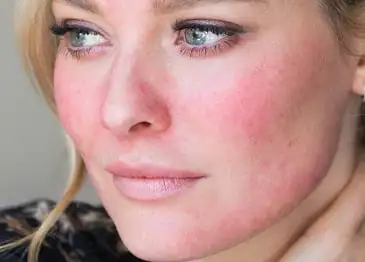
What it is?
Rosacea is a chronic skin pathology of a non-infectious nature, which mainly affects mature patients. The inflammatory process occurs with a gradual increase in symptoms, frequent redness of the skin, telangiectasias (persistent dilation of small blood vessels), persistent erythema, the formation of papules, pustules, and in rare cases, nodes.
Causes
Today, the causes of rosacea have not been fully studied, however, there are several theories that claim that hereditary factors, disruption of the adequate functioning of the immune defense, endocrine and gastrointestinal diseases play an important role in the development of this disease.
- Mental theory of disease development. For quite a long period of time, it was believed that one of the fundamental causes of the development of rosacea on the face was various mental disorders, but this fact has not been confirmed by sufficiently numerous studies. The only connection between rosacea and mental illness is the development of severe mental conditions against the background of severe forms of rosacea. This usually manifests itself as emotional instability, depressed mood and depression.
- Hereditary theory of development. Most scientists categorically deny a genetic factor in the development of rosacea. However, despite this, relevant studies conducted in the United States have shown that in more than 40% of patients with rosacea, this disease is observed in their closest relatives. In addition, in the appropriate honey. Family cases of this disease have been repeatedly described in the literature.
- Theory of the role of ticks in the development of disease. Some scientists associate the appearance of rosacea with exposure to Demodex mites. This theory is confirmed by the detection of mites in the studied materials taken from problem areas of the skin. However, due to the fact that not all patients have larvae of these mites, this theory has not yet received final confirmation. If mites are found with rosacea, a diagnosis of rosacea-like demodicosis is made.
- The role of diseases of the digestive system. This, like the hereditary theory, also has a lot of opponents, but thanks to numerous studies and observations, symptoms of small intestinal diseases were found in 35% of patients with rosacea and signs of gastritis in almost 90% of patients.
- The theory of the influence of external factors. In recent years, the theory has been persistently discussed that the consumption of alcoholic beverages, coffee and spices, due to a negative effect on the gastric mucosa, leads to a reflex dilation of blood vessels on the face. However, studies have proven that dilation of facial vessels does not develop after consuming the above products, but due to the ingestion of liquid heated to more than 60°C into the body, more precisely into the stomach. However, despite this, patients with rosacea are advised to exclude citrus fruits, spicy foods, alcoholic drinks and coffee from their diet.
- Infection theory. Due to the fact that with rosacea, a pustular rash appears on the skin of the face, a certain role in the development of this disease is assigned to an infectious factor, or, more precisely, to bacteria. The infection theory is also confirmed by the fact that when antibiotics are prescribed, there is a significant decrease in the manifestations of rosacea. Despite this, it was not possible to recognize any bacteria or viruses in the contents of the purulent rash that could cause the development of this disease.
Typically, this disease is observed in females, while in males it progresses more rapidly with the predominant development of serious complications. Typically, pink acne occurs in fair-skinned people aged 39 to 55 years (rosacea rarely affects older people, as well as children).
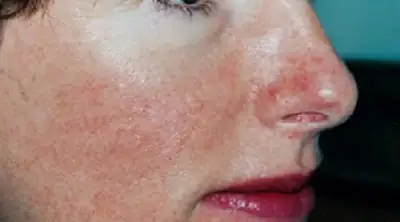
Symptoms
The symptoms of rosacea (see photo) are quite typical, they are almost impossible to confuse with signs of other diseases.
So, the main symptoms of rosacea on the face are:
- A pink rash that appears against a background of redness. First, these are papules (pink bumps), which then transform into pimples with purulent contents (pustules, blackheads). This stage is called papulopustular.
- Persistent redness in the center of the face (in the T-zone). That is, redness affects the nose, cheeks, chin and nose. Sometimes the redness can be more extensive, involving the chest and back of the patient. These symptoms are characteristic of the erythematous stage.
- The appearance of a red vascular wall on the facial skin (telangiectasia) throughout the affected area, the appearance of red and bluish nodules are typical in the erythematous-papular stage of the disease.
- Eyes that are red, watery, or feel dry. The patient may also feel a pain in the eyes, as if a foreign body had entered them. Having studied the symptoms of rosacea, researchers of this disease have created several different, rather complex classifications of stages and forms. The stages described above belong to one of the most common classifications of the disease.
- Thick, crusty facial skin in areas of redness. Red and thick skin on the nose. Due to hypertrophy of the sebaceous glands and connective tissue, the nose can significantly increase in size, and bumpy nodes appear on it, separated by grooves. This is the most severe, nodular stage of rosacea, which is also called rhinoform. Most often diagnosed in men 50-60 years old.
Clinically, there are several forms of rosacea:
- Erythematous-telangiectatic. The erythema is persistent (lasts for several days). Multiple telangiectasias appear on the skin of the cheeks.
- Phymatous (or papular-nodular). This form is characterized by the appearance of nodes and plaques. There is an increase in the size of the rashes with their subsequent merging. Fibrosis and hyperplasia of the sebaceous glands leads to enlarged areas of the skin (“fima”).
- Papulopustular. Against the background of the resulting erythema, groups of small papules with thin scales appear on the surface. They are located first on the skin of the nose and nasolabial folds, then spread to the skin of the forehead and chin. Some papules transform over time into pustules filled with sterile contents. Skin infiltration and swelling often develop.
- Ocular. Includes blepharitis, conjunctival infections, conjunctivitis, keratitis, iritis, chalazion, etc. Patients may be bothered by photophobia, blurred vision, itching, lacrimation, dry eyes, foreign body sensation, etc. Eye symptoms can be detected in 50% of patients with cutaneous forms of rosacea. Detailed clarification of eye symptoms and patient awareness of this form of rosacea help promptly consult an ophthalmologist.
Rosacea most often occurs in women over 30 years of age, with the exception of the phymatous form, which is more common among men. Light-skinned Caucasians are more often affected. In people with darker skin color, rosacea may be more difficult to recognize.
What does rosacea look like: photo
The photo below shows how the disease manifests itself in adults.
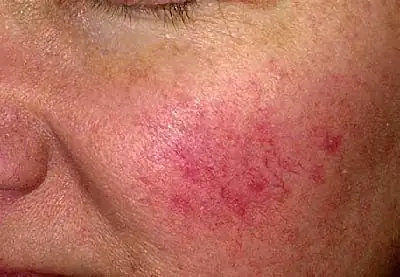
Diagnostics
This skin disease is diagnosed by examining the patient's skin. A videodermatoscope can be used to examine the affected areas in detail.
If there is a suspicion of infection with a subcutaneous demodex mite, a skin scraping analysis is performed. If there are purulent rashes, the doctor prescribes bacterial culture of the acne contents. It may also be recommended to take a urine and blood test and do an ultrasound examination of internal organs.
Complications
Possible complications of rosacea:
- abscess formation;
- development of secondary infection;
- pineal nose (rhinophyma) or thickening of the skin on other areas of the face;
- damage and inflammation of the cornea of the eye, decreased visual acuity;
- psychological problems, nervous disorders (depression, insomnia, irritability, fatigue).
How to treat rosacea?
First of all, the efforts of doctors should be aimed at relieving the symptoms of the disease. In order to prevent its development, pathogenetic therapy is prescribed, and to prevent relapses, etiotropic treatment is prescribed.
It should be understood that rosacea is a fairly serious disease, and not a simple skin inflammation or cosmetic defect, so you should not hope for a complete cure.
When prescribing treatment, the causes of the disease are taken into account. It is carried out in a complex, and the combination of medications is selected depending on the stage and form of the disease, taking into account the individual characteristics of the patient’s body.
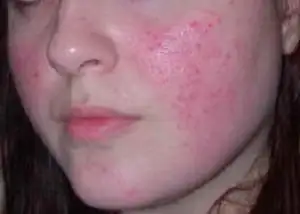
Local treatment and antibiotics
Such treatment consists of the use of ointments and creams containing an antibacterial component (Metrogil, Rozamet, Rozeks), ichthyol, and naftalan oil. In the initial stages, lotions with a solution of boric acid and mash, which are prepared in pharmacies according to a doctor’s prescription, help well.
The most popular topical drugs are:
- Cream for rosacea on the face Ovante. A natural preparation containing plant extracts and microencapsulated crystalline sulfur. The drug is completely safe, provides a pronounced cosmetic effect and can be used for a long time without harm to health.
- Skinoren is a gel. Contains azelaic acid, which has a pronounced anti-inflammatory and anti-edema effect, and has a drying effect on rashes. The drug has virtually no contraindications; it can be used during pregnancy and breastfeeding. The gel is applied to clean facial skin 2-3 times a day; a lasting positive result can be achieved only with regular use of the drug.
- Hormonal preparations for external use. These remedies give a quick positive effect, but they should be used in short courses. They must be prescribed by a doctor, and treatment is carried out under his supervision. Many experts doubt the advisability of using hormonal ointments, since the positive results from their use are short-term, and after withdrawal there is a rapid return of symptoms in a more severe form. In addition, there is a risk of rosacea turning into a steroid form, which is difficult to treat.
Also, antibiotics of the tetracycline group (oxytetracycline, minocycline, tetracycline hydrochloride) have proven themselves to be effective in the treatment of rosacea. Metronidazole shows high effectiveness in the fight against rosacea; it copes with many types of bacteria and destroys subcutaneous mites. In addition, Metronidazole has an anti-edematous effect and has a beneficial effect on the restoration of the gastric and intestinal mucosa.
To eliminate severe itching and irritation, antihistamines (Tavegil, Suprastin, Claritin) are prescribed. When spider veins appear, the vitamin complex ascorutin is prescribed, which strengthens the walls of blood vessels. To calm the nervous system, motherwort or valerian are recommended; in severe cases, antidepressants are prescribed.
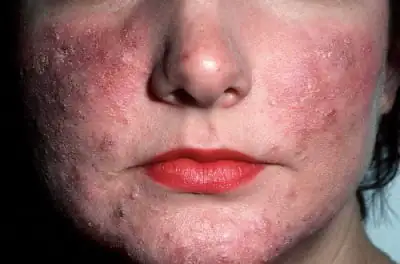
Physiotherapeutic treatment
Treatment of rosacea can be supplemented with the following physiotherapeutic techniques:
- Electrocoagulation. The affected area is exposed to electric current through a thin electrode. This method removes papules, pustules and telangiectasias, but may leave burns on healthy skin.
- Cryotherapy. Can be used at any stage of the disease. The affected area is exposed to low temperatures using liquid nitrogen. This technique reduces the appearance of telangiectasias and improves the appearance of the skin.
- Laser therapy. A laser beam is directed at the area with telangiectasia, which causes heat on the blood vessel and destroys it. This procedure allows eliminating telangiectasias for a longer time and is not accompanied by damage to healthy tissues as with electrocoagulation.
- Rotational massage. The affected areas are massaged with circular stroking movements twice a day. This method improves lymph flow and reduces tissue swelling.
If rosacea is complicated by abscesses and fistulas, the patient may be recommended surgical treatment aimed at excision of pathological foci and installation of drainage for better outflow of purulent discharge. After performing such interventions, the patient is prescribed dressings using antibiotics and other anti-inflammatory and disinfectants.
Treatment of rosacea with folk remedies
The following herbs and plants are used to treat rosacea:
- A series. To prepare the infusion, use 1 part herb to 30 parts water. A napkin moistened with the solution is applied to the face for 30 minutes.
- Chamomile. For rosacea rosea, use an infusion of flowers (prepared in a ratio of 1:15). After preparing the solution, the same procedure is performed as with calendula.
- Calendula. You can use ready-made calendula tincture purchased at the pharmacy. 50 ml of tincture is diluted in a glass of cold water. Soak a towel or gauze folded in several layers with the resulting solution. After squeezing a little, the gauze is applied to the face for 3 hours. The procedure is carried out once a day.
- Cranberry. At home, you can treat rosacea with cranberry juice. Wet-dry dressings are most effective. To do this, gauze folded in 10 layers is soaked in cranberry juice, then applied to the face, covered with a layer of cotton wool on top. Secure this bandage with a bandage and leave it for 30-60 minutes. If you are using cranberries for the first time, the juice should be diluted with water in a ratio of 1:3. If the skin reacts well, you can gradually increase the concentration and switch to undiluted cranberry juice.
Traditional methods of treating rosacea very often give a good cosmetic effect. It is better to start treatment and skin care for rosacea with lotions. For this, decoctions, juices and plant extracts can be used. One of the most important conditions for effective treatment is that all solutions must be cooled!
Cosmetics
What cosmetics should I use? Here are the basic rules:
- If the eyelids and eyes are affected, wipe them with decoctions of medicinal herbs.
- Cleanse your face with cosmetic milk, which gently removes impurities from the skin.
- For rashes on the head, use medicated shampoo and make masks to reduce inflammation.
- Use oils to soften your skin. Add a few drops of tea tree oil and St. John's wort to olive oil.
- Buy quality skin care products from reputable cosmetic companies.
- Rashes, red spots, ulcers, orange peel are prohibited from being masked with foundation. The pores will become clogged even more, and the inflammation will intensify. The manifestations of rosacea under a layer of powder or foundation look even more repulsive.
- Use a light day and night cream for problem skin. Choose a medicinal cream, consult a dermatologist to see if the product you choose is suitable. Apply a thin layer of cream.
Diet and nutrition
Treatment for rosacea on the face necessarily includes dietary nutrition:
- It is necessary to exclude alcohol, hot strong tea and coffee.
- in severe cases, therapeutic fasting may be prescribed according to indications.
- All provoking factors are excluded - spicy, salty, smoked, canned food. During treatment, you should refrain from sweets and some fruits (pears, grapes, citrus fruits).
- greens and vegetables;
- cereals and lactic acid products;
- lean meat and fish, preferably steamed;
- boiled potatoes and eggs;
- crackers or stale bread.

Prevention
To prevent relapse of the disease, the patient must follow the following rules:
- avoid excessive emotional and physical stress;
- avoid visiting solariums, beaches without shelter from the sun and saunas;
- avoid eating too hot or cold food;
- follow a diet that excludes the consumption of spicy, salty, spicy foods;
- stop drinking alcohol;
- use sunscreen;
- periodically visit a cosmetologist and dermatologist;
- use only high-quality cosmetics;
- constantly cleanse the skin with products recommended by your doctor;
- promptly treat diseases of internal organs;
- take hormonal drugs only on the recommendation of a doctor;
- do not self-medicate.
Along with rosacea, there is another skin pathology that has similar symptoms and causes. We are talking about rosacea - damage to the blood vessels of the facial skin. In the past, rosacea was not considered a serious condition. It was called the "painful blush" disease, and was believed to be a cosmetic defect resulting from excessive alcohol consumption. But even today the mechanisms of the occurrence and development of this disease are not entirely clear.
Causes and mechanisms of rosacea
Rosacea is a chronic skin disease that manifests itself as persistent redness of the skin of the cheeks, nose, forehead, which manifests itself in the form of bright pink rashes, spider veins, pustules and skin atrophy.
Even today, unfortunately, it is impossible to say with complete confidence about the causes and mechanisms of rosacea. There are two assumptions: on the one hand, it is believed that the disease is based on the high sensitivity of blood vessels to various physical influences of the environment (cold, heat, dry air, or sudden changes in temperature), and on the other hand, it is believed that the disease is hereditary in nature . That is, the fragility and fragility of blood vessels is a genetic predisposition, since the majority of people do not have any reactions to such irritants.
There was an assumption that the disease is caused by a mite called demodex (Demodex folliculorum), which parasitizes the skin of the face and the sebaceous glands of the hair follicles. It was also believed that this mite causes the disease demodicosis, which contributes to the occurrence of rosacea. However, modern research has established that demodex is found on the skin of absolutely healthy people and does not need to be treated.
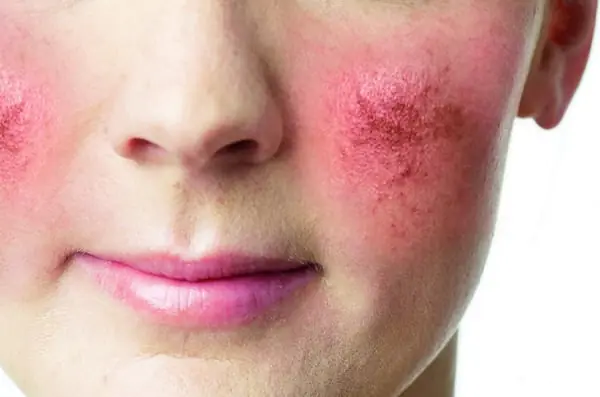
There is also an assumption that the occurrence of rosacea is closely related to diseases of the gastrointestinal tract. The appearance of rosacea is caused by the bacterium Helicobacter pylori, which is responsible for the development of gastritis and gastric ulcers. Thus, people with gastritis and peptic ulcers are more susceptible to rosacea than those in whom this bacterium is not detected.
There is an opinion that medications can also cause rosacea. And this is partly true. Thus, corticosteroid ointments that cannot be used on the face can cause “steroid rosacea.”
Thus, rosacea is more likely to develop in the following cases:
- in women during menopause, puberty or pregnancy, since during this period hormonal levels change, which affects the condition of blood vessels;
- in people with very fair skin, the “Celtic” phenotype. It’s not for nothing that the British called rosacea “the curse of the Celts”;
- in people with sensitive skin and fragile blood vessels;
- in persons suffering from chronic forms of allergic and contact dermatitis;
- in case of disturbances in the functioning of the endocrine system;
- in persons suffering from vegetative-vascular dystonia, with damage to the vascular network of the face;
- in persons with diseases of the gastrointestinal tract;
- when drinking alcohol, hot or spicy foods;
- with a sharp change in temperature outside, indoors, in saunas and baths.
Rosacea occurs in both sexes, but women are more likely to suffer from this condition. From a genetic point of view, northern peoples living in a sharply continental climate are more predisposed to the appearance of rosacea than people living in warm countries.
Symptoms of rosacea
The symptoms of rosacea can be divided into several stages:
- Early stage.
- Development of the disease.
- Chronic stage.
At an early stage, the symptoms of rosacea, which presumably appear after contact with cold or hot water, after drinking very hot drinks and alcohol, with a sharp change in temperature, the face instantly becomes covered with red spots that do not disappear for some time. But it should be noted that they still disappear. Therefore, this fact does not always cause anxiety in patients, since it is not associated with unpleasant sensations and is positioned as a temporary phenomenon.
At this stage, redness is localized on the forehead, nose, cheeks and chin, completely affecting the T-zone. Most often, patients do not go to the doctor, and all their actions come down to masking the defect with cosmetics.
With the further development of the disease, a persistent expansion of the capillaries appears, which contributes to a local increase in temperature and allows the local microflora to actively reproduce. At this stage, tubercles and irregularities on the skin form, which then transform into purulent elements. The skin takes on a rough appearance, becomes dense, swelling appears on it, and vasodilatation (telangiectasia) is observed constantly, without provoking factors.
The chronic stage of the disease is manifested by the appearance of periorbital and perioral rashes in the form of bright red nodules and papules, which tend to merge and form extensive conglomerates. In the affected areas, the skin becomes lumpy, with irregularities and depressions.
With further progression of the disease, the eyelids and skin around the eyes are affected. The process of blinking causes a certain discomfort: there is itching, burning, pain and dryness in the eyes, tightening of the skin around the eyes, the appearance of “goosebumps”, as well as profuse lacrimation. This form of the disease is called ocular rosacea. However, it happens that clinical symptoms of eye lesions are several years ahead of skin lesions. Sometimes ocular rosacea provokes the appearance of rosacea keratitis, which leads to vision loss.
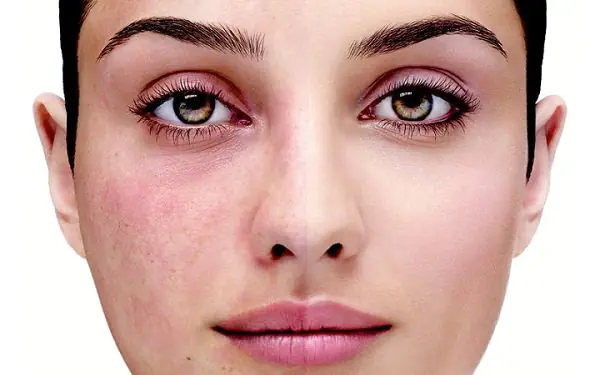
Rosacea can develop rapidly during pregnancy, but after childbirth, with appropriate therapy, it goes away without a trace. But with each subsequent pregnancy there is a risk of recurrence of the disease.
In men, rosacea is localized mainly on the nose, with roughening and thickening of the skin and is complicated by rhinophyma (a disease of the skin of the nose, which is characterized by thickening, roughening and disfigurement of the nose).
Diagnosis of rosacea
An experienced specialist diagnoses the disease based on clinical manifestations. But there are some skin diseases that require differential diagnosis. To do this, a study of the microflora of the facial skin and the condition of blood vessels is carried out. Sometimes there is a need for a biochemical blood test. If purulent elements are observed on the face, their contents are examined using bacteriological culture.
Rosacea treatment
Treatment of rosacea is carried out in two directions:
Local treatment includes the use of medicinal ointments and creams with ichthyol, naphthalan or metronidazole. Herbal applications in the form of compresses and lotions made from medicinal herbs (yarrow, celandine, chamomile and sage) have an anti-inflammatory effect and reduce skin redness. However, this does not cure the disease completely, but rather is temporary. It should be noted that there is no magic remedy in the form of an ointment or cream that would permanently rid the patient of this disease. Therefore, treatment of rosacea is a complex process with complex treatment regimens.
Antibiotics are often used to treat various forms of rosacea, but they do not always help. For this reason, you should not self-medicate and prescribe antibiotics yourself. This decision should only be made by a doctor, based on the clinical picture and taking an anamnesis. Antibiotics are usually prescribed when purulent rashes appear on the skin, indicating bacterial invasion. If local treatment with antibiotics does not lead to success, then oral antibiotics are prescribed in the form of general drug treatment.
For a long time, rosacea was treated according to old knowledge about the disease and using old treatment regimens, which did not at all contribute to the patient’s recovery.
Rosacea is treated in courses ranging from several weeks to several months. Do not forget that rosacea is a chronic disease that is difficult to treat, since the mechanisms that trigger it have not been precisely established.
The initial stages of rosacea are very treatable, so at the first symptoms of the disease you should immediately consult a doctor rather than let the disease progress. And complex forms, aggravated by complications such as rhinophyma and telangiectasia, require long and persistent treatment.
Laser treatment for rosacea has a good therapeutic effect.
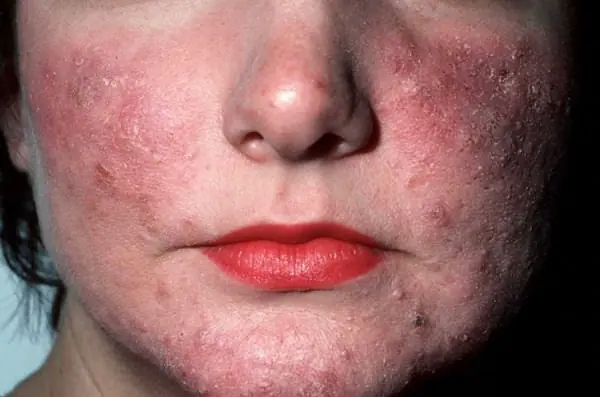
In advanced stages, with independent incompetent treatment, a conglobate form of rosacea develops, which is characterized by abscesses and the presence of purulent fistulas. In this case, surgical treatment is recommended with removal of the purulent element and installation of drainage to drain the contents of the fistula.
If purulent fistulas are eliminated and the treatment has given a positive therapeutic response, then it is necessary to eliminate the immediate cause of the disease - spider veins. To remove the vascular network, cryotherapy and photocoagulation are used. These procedures are the only reliable methods for removing dilated vessels on the face. After complete healing, it is necessary to use sunscreen with a high protection factor in any weather.
Traditional electrocoagulation, which affects the skin with a weak electrical impulse, cryodestruction (destruction of the capillary network with liquid nitrogen), dermabrasion and some forms of peeling also have a good effect.
Prevention of rosacea
Prevention of the disease is manifested in protecting the skin from the physical effects of the environment: from ultraviolet radiation, hot air, severe frost and wind. You should refrain from drinking hot drinks, hot and spicy foods and alcohol. You should use special medicinal and decorative cosmetics for sensitive skin containing horse chestnut, which not only does not irritate the skin, but can also protect it from the effects of undesirable factors.
Since rosacea is a chronic disease, a systematic visit to a cosmetologist is necessary to quickly eliminate individual elements in the form of hypertrophied blood vessels. If you follow all the doctor’s recommendations, the disease may recede, and preventive visits to a cosmetologist can be reduced to 2-3 times a year.



